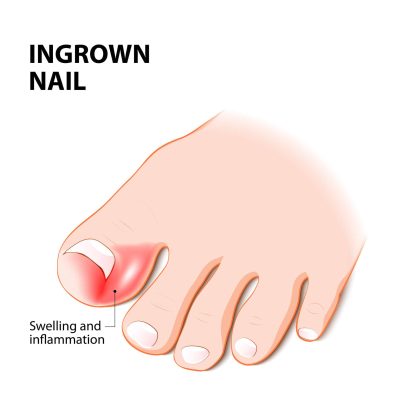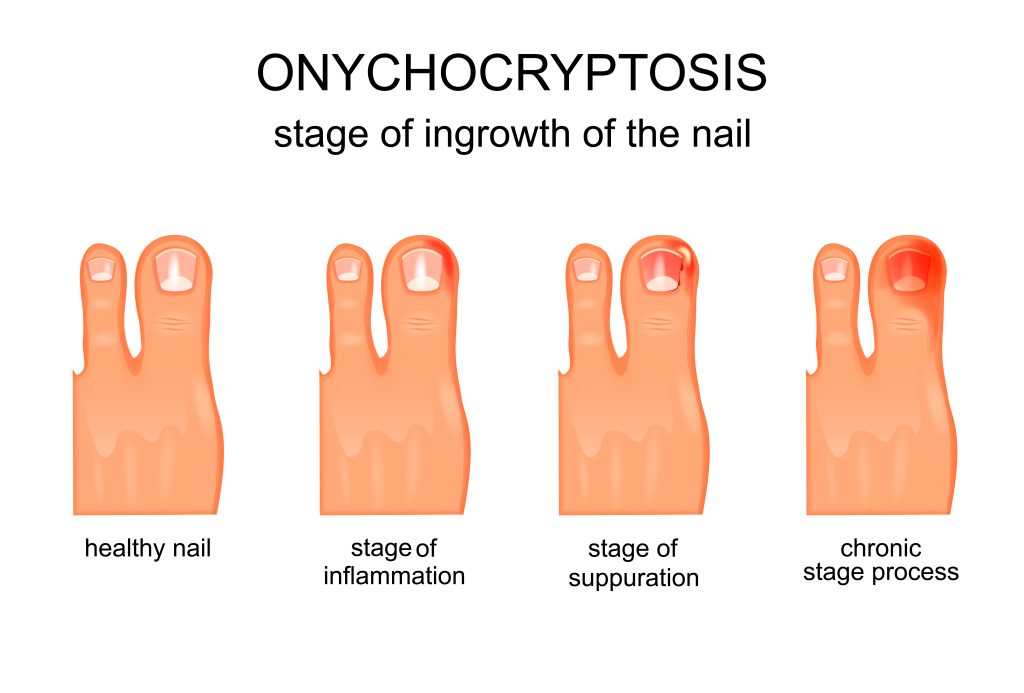Lasting Ingrown Toenail Solutions & At Home Remedies
A very common foot ailment, ingrown toe nails cause discomfort and infection when the toenail grows into the skin. Poor nail trimming, tight shoes, or genetics can cause this big toe trouble.
Nail redness, swelling, and tenderness are common symptoms. Prevention includes nail care and well-fitted shoes. Warm soaks, careful nail pulling, and over-the-counter pain medication can treat mild instances at home.
What Is An Ingrown Toenail?
Ingrown toe nails, medically known as onychocryptosis, is a prevalent issue affecting individuals of various ages.
This condition can significantly disrupt your daily activities, including sports, school, or work, adversely impacting your overall quality of life.
The problem arises when the toenail starts to grow into the skin around the nail or its base.
This abnormal growth leads to trauma and inflammation in the affected area, resulting in discomfort and pain.
Additionally, the trauma inflicted by the ingrown nail on the skin can create an entry point for infections.
In cases where an infection sets in, it can rapidly escalate the level of pain experienced.

Causes & Risk Factors For Ingrown Toenails
The growth of your nails originates from the nail root, which is situated under the skin of your toe. This region is known as the nail matrix and its size and shape can differ from person to person. As a result, your nails may develop to be either flat or curved, and either wide or narrow in shape. Each individual’s characteristics are unique.
Ingrown toenails, a condition when the nail grows into the borders of the surrounding skin, are more common in those with curved or wide toe nails.
Many factors can contribute to ingrown toe nails, including:
- Incorrect techniques in cutting nails
- Habit of picking at nails
- Wearing tight shoes, particularly high heels
- Shoes with pointed toes
- Certain sports footwear, like football and soccer boots
- An abnormal nail shape, such as an excessively curved nail
- Excessive sweating of the feet
- Lack of proper foot hygiene
- Presence of bunions
- Inadequate foot movement patterns
- Injury to the nail or nail bed
- Fungal nail infections
In rare cases, bone spurs underneath the nail can lead to an ingrown toe nail.
Ingrown Toenail Symptoms
Ingrown nails can lead to discomfort at the toe’s tip or along its edge. Beyond localized pain, ingrown toe nails can exhibit several symptoms:
- Area that feels hot, swollen, and sensitive
- Increased pain, redness, and signs of infection as the condition progresses
- Exacerbated pain when wearing shoes or under bed sheets
- Tenderness upon touch
- In advanced stages, there might be discharge of pus and the formation of hypergranulation tissue
- Significantly ingrown toe nails can present with a discolored, yellow nail on the big toe

While these signs are typically indicative of an ingrown toe nail, they could also signify other conditions like an involuted nail, subungual corn, or a thickened nails. Getting an accurate diagnosis is crucial, as incorrect care can harm the toenail, lead to infections, and intensify the pain.
Ingrown Toenail Remedies
Home Remedies for Toenail Treatment (non-clinic nail treatment)
In cases of a minor ingrown toe nail without infection in the nail bed, you may consider these home remedies to alleviate or reduce discomfort:
- A foot soak in salted, warm water (using 1 tablespoon of salt per 1 litre of water) can help decrease swelling and ease tenderness. Soak your feet for 10-15 minutes once or twice daily.
- Gently filing the corners of the toe nail can smooth out any sharp edges.
- Steer clear of tight-fitting and pointed-toe shoes.
In Clinic Toenails Treatment
Ingrown Toenail Treatments
Should your ingrown toe nails fail to improve with home remedies, it’s advisable to seek professional care from our podiatrists. Our clinic is located in Rosanna, in the North East Melbourne metro area.
At Bellevue Podiatry, our team has successfully managed thousands of feet over our 11+ years of operation, offering both non-surgical and surgical treatments for ingrown toe nails. Despite being a common issue, ingrown toe nails can be difficult to manage on your own, emphasising the need for an accurate diagnosis and a tailored remedy plan.
Our primary objective during the initial consultation is to alleviate pain and address any infection or inflammation caused by the ingrown toenail.
If your toe is not infected, we may be able to gently trim the ingrown nail edge painlessly, a non-surgical approach to treating your ingrown toenail. This procedure can be repeated at regular intervals, typically every four to six weeks, to help prevent the recurrence of the issue.
Non-surgical & Pain-free Ingrown Toenail Options
Before we consider nail treatment that may require nail avulsion (i.e. ingrown toe nail surgery), there are two very effective and painless options that can treat ingrown toe nails.
BS Brace toenail treatment
Onyfix nail treatment
Onyfix: Onyfix utilises a topical application that is hardened using LED light on the ingrown toenail. It acts as a brace for your nail ensuring it grows in the shape from root, to tip. This alters the growth pattern of the nail over time and painlessly and safely returns it to the correct shape.
Ingrown Toenail Surgery
We may recommend ingrown toenail surgery as a nail therapy under local anaesthetic as a long-term therapy, depending on the severity and recurrence of your ingrown toenail from our podiatrist assessment. The types of nail surgery we offer include:
- Partial Nail Avulsion (PNA): In this common, minimally invasive surgery procedure, the problematic nail edge is removed and the nail matrix is sterilized with a chemical known as Phenol.
- Total Nail Avulsion (TNA): TNA surgery entails the complete removal of the affected nail and subsequent sterilisation of the nail matrix with Phenol. This method is less common and reserved for specific cases.
- Wedge Resection: This more invasive surgery technique involves cutting a segment of the skin and nail bed to reveal the nail matrix, followed by the removal of either part or all of the nail matrix. The skin and nail bed is then sutured back.

Each of these procedures is virtually pain-free, thanks to local anaesthetic for your toe, and the recovery period for your toenail from surgery is generally brief. Most patients can resume work the following day, provided they can wear open-toed footwear, such as sandals or thongs, for a few days. There is no need for physical therapy or any kind of significant medical rehabilitation, for the most part, after the nail surgery, you can resume normal activities once you leave the clinic.
Ingrown Toenail Treatments Prevention
Ingrown toe nails can be quite uncomfortable, and it’s important to take steps to prevent your toenails from needing an ingrown toenail treated. While you can’t alter the natural shape of your nail or completely dodge external risk factors, not all ingrown nails are inevitable.
There are several measures you can take to lower your chances of developing ingrown toenails and needing ingrown toenails remedies:
- Trim your nail straight across, and gently file the toenail edges to prevent sharp corners from digging into the skin and nail bed.
- Choose footwear and shoes that aren’t too snug around your toes or toenails, ensuring there’s about a thumb’s width of space between your toes and the shoe tip.
- Opt for open-toe or breathable shoes, especially beneficial for those with sweaty feet.
Don’t put up with toenail pain any longer – the ingrown pain will likely worsen the longer you try to ignore it. Call us today on (03) 4240 5231 or schedule an appointment online today to see one of our podiatrists and let us get you back on your feet pain free with healthy nails.
Ingrown Toenails
Understand how you get ingrown toenails and what you can do to get rid of them once and for all. You don't need to put up with the pain of an ingrown toenail any longer.

